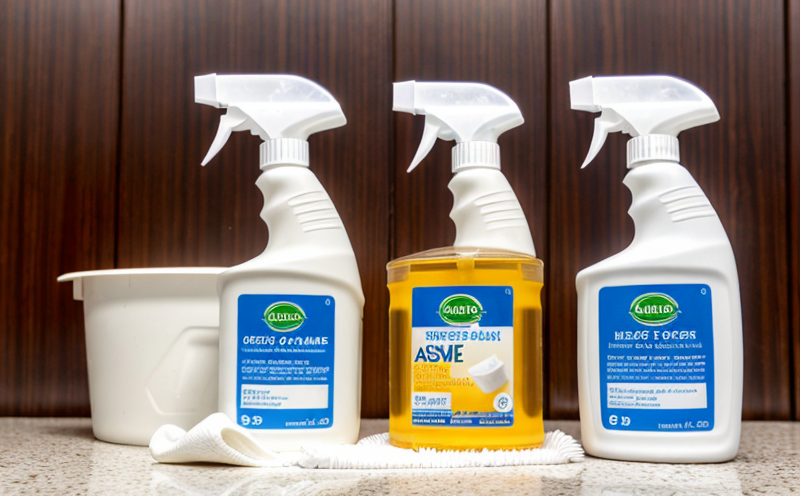ASTM E2721 Determination of Antiviral Activity Testing
The ASTM E2721 standard is a pivotal method used to determine the antiviral activity of various cleaning and hygiene products. This testing protocol is crucial for ensuring that disinfectants, soaps, and other antimicrobial agents effectively combat specific viruses without compromising their efficacy or safety.
ASTM E2721 outlines a series of steps designed to measure how well these products can inhibit viral replication. The test involves inoculating virus-containing media with the sample being tested and comparing it against control samples that do not receive the treatment. This comparison helps in quantifying the antiviral activity, which is critical for product labeling claims and regulatory compliance.
The scope of ASTM E2721 includes a variety of products such as hand sanitizers, wipes, sprays, and other disinfectants commonly used in healthcare settings, schools, and public spaces. It ensures that the products meet stringent antiviral activity requirements set by international standards like ISO 21766.
The testing process typically involves several key steps:
- Preparation of virus-containing media
- Application of the disinfectant sample to the media
- Incubation period for viral replication
- Measurement and comparison of viral titers between treated and untreated samples
The acceptance criteria in ASTM E2721 are based on the reduction in viral titer compared to the control. A significant reduction indicates effective antiviral activity, which is essential for product approval and market entry.
ASTM E2721 is widely recognized for its accuracy and reliability, making it a preferred choice by manufacturers, regulatory bodies, and quality assurance departments. It ensures that products meet the stringent requirements set forth by health organizations like the World Health Organization (WHO).
The testing protocol also helps in identifying the optimal concentration of active ingredients necessary to achieve effective antiviral activity while minimizing potential side effects or irritants. This is particularly important for developing new formulations and optimizing existing products.
Furthermore, ASTM E2721 supports the development of more sustainable and eco-friendly disinfectant solutions by providing a framework for evaluating their environmental impact alongside their efficacy. This ensures that the products not only perform well but also meet broader sustainability goals.
Benefits
The ASTM E2721 Determination of Antiviral Activity Testing offers numerous benefits to manufacturers, quality managers, and compliance officers. By ensuring that products meet stringent antiviral activity standards, companies can:
- Enhance product safety and efficacy
- Avoid potential legal disputes related to false claims or ineffective products
- Meet regulatory requirements set by health organizations like the FDA and WHO
- Gain a competitive edge in the market through superior product performance
Quality managers can rely on ASTM E2721 to maintain consistent product quality, ensuring that each batch meets the required standards. Compliance officers benefit from this testing method by avoiding costly regulatory issues and potential recalls.
Quality and Reliability Assurance
The ASTM E2721 Determination of Antiviral Activity Testing is a cornerstone for maintaining quality and reliability in cleaning and hygiene products. The testing process involves several critical steps that ensure the accuracy and consistency of results:
- Stringent preparation of virus-containing media
- Standardized application methods to ensure even distribution of the disinfectant sample
- Consistent incubation conditions to allow for accurate viral replication
- Accurate measurement and comparison techniques to quantify antiviral activity
The use of ISO 21766 in conjunction with ASTM E2721 further enhances the reliability of these tests. This international standard provides additional guidance on the preparation of test samples, ensuring that all laboratories conducting this testing follow a consistent methodology.
Regular calibration and validation of equipment are essential to maintain the precision and accuracy of results. This ensures that the testing process remains reliable over time, even as new formulations or technologies emerge.
Competitive Advantage and Market Impact
- Enhanced Brand Reputation: Companies that adhere to rigorous antiviral activity testing standards like ASTM E2721 can enhance their brand reputation by demonstrating a commitment to product safety and efficacy.
- Increased Market Share: Products with proven antiviral activity are more likely to attract consumers seeking reliable hygiene solutions, thus increasing market share.
- Regulatory Compliance: Meeting ASTM E2721 standards ensures compliance with regulatory requirements, avoiding potential legal and financial risks associated with non-compliance.
The testing process also supports the development of innovative products that meet both current and future needs. By staying ahead of emerging trends in antiviral technology, manufacturers can maintain a strong competitive position in the market.





